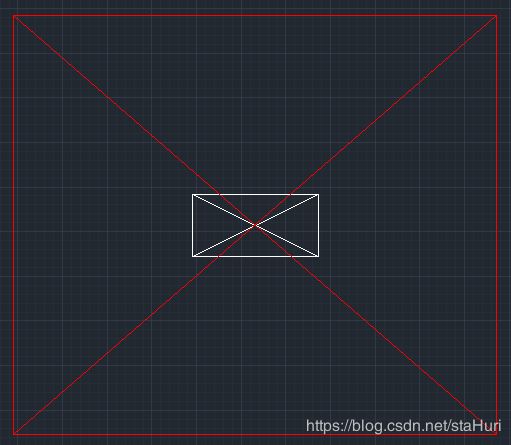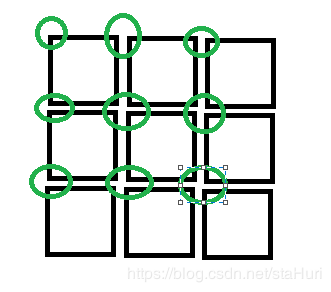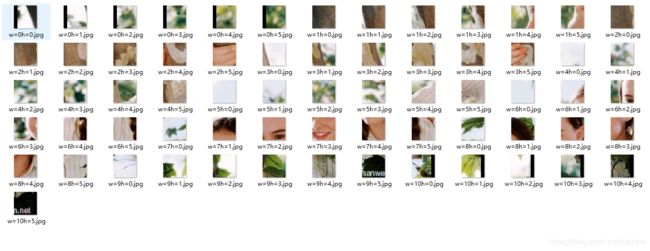tensorflow 按区域提取实例
tensorflow 按区域提取实例
需求
- 输入一张图片,按照规定正方形尺寸(如30*30 像素) 对输入图片进行提取,类似于口 ,田两个文字 一张图变成四张,四张图能够变成一张图。
数据与思路
数据资源
思路
-
根据输入情况来看 534 不能够被30 整除,需要对534这个宽度进行调整 。300则被30整除不需要进行特殊处理。
- 遇到除不尽的处理方式 : (被提取图片的宽度或高度 // 提取尺寸 +1 )* 提取尺寸
-
经过第一步操作得到一个新的尺寸 , (540,300) 我们需要将原尺寸填充到这个尺寸中。tensorflow 内置了这个功能 , **tf.image.resize_image_with_crop_or_pad ** 这个函数的作用是将一个图片填充到一个新的尺寸中,且两个图的中心不变。
- 上图中红色部分为经过 **tf.image.resize_image_with_crop_or_pad **处理后的图形尺寸,白色部分为原始尺寸。
-
经过第二部获得一张新的图片,我们最终操作的也就是这个图片 , 所使用的函数 tf.image.crop_to_bounding_box
def crop_to_bounding_box(image, offset_height, offset_width, target_height,target_width): """ image = 图片内容 offset_height = 开始的h offset_width = 开始的w target_height 纵向位移长度 target_width 横向位移长度 """最终需要计算下图中绿色的角点位置作为 offset_height , offset_width 的参数,target_height , target_width 则是提取尺寸
-
保存数据
- 使用 imageio 库进行保存,**imageio.imwrite(“保存地址”, tf.eval()) 这就保存完成 **
代码以及结果
#! /usr/bin/env python
# -*- coding: utf-8 -*-
# __file__: huifer
import tensorflow as tf
import imageio
from PIL import Image
import os
BASE_PATH = os.path.join(os.path.abspath(os.curdir), 'data')
BASE_PATH_res = os.path.join(os.path.abspath(os.curdir), 'result')
def get_pic_size(path):
"""
获取图片尺寸
:param path: 图片路径
:return: (高度,宽度)
"""
decode_jpeg_data = tf.placeholder(dtype=tf.string)
decode_jpeg = tf.image.decode_jpeg(decode_jpeg_data, channels=3)
image_data = tf.gfile.FastGFile(path, 'rb').read()
with tf.Session() as sess:
image = sess.run(decode_jpeg, feed_dict={decode_jpeg_data: image_data})
return (image.shape[0], image.shape[1])
def _size(pic, split):
"""
处理图片尺寸 , 不能整除向上取一位
:param pic: 图片的尺寸 ,宽度或者高度
:param split: 切割尺寸,宽度或者高度
:return: 图片尺寸 ,宽度或者高度
"""
if pic % split == 0:
return pic
else:
return (pic // split + 1) * split
def get_new_size(pic_size, split_size):
"""
计算新的图片尺寸
:param pic_size: 原始图片尺寸(高,宽)
:param split_size: 切割图片尺寸(高,宽)
:return:
"""
return (_size(pic_size[0], split_size[0]), _size(pic_size[1], split_size[1]))
def fill_pic(path, new_size, new_path):
"""
填充图片到指定的新尺寸
:return:
"""
# tf.train.string_input_producer 接收参数是一个文件列表['1.jpg','2.jpg'] , 由于实际操作中可能多个每个图片最后填充结果不一致,
# 所以在这个测试用例中直接将一个地址放在列表中
filename_queue = tf.train.string_input_producer([path])
reader = tf.WholeFileReader()
key, value = reader.read(filename_queue)
images = tf.image.decode_jpeg(value)
with tf.Session() as sess:
coord = tf.train.Coordinator()
threads = tf.train.start_queue_runners(coord=coord)
# 填充图片底色黑色
reshapeimg = tf.image.resize_image_with_crop_or_pad(images, new_size[0], new_size[1])
reimg1 = reshapeimg.eval()
imageio.imwrite(new_path, reimg1)
coord.request_stop()
coord.join(threads)
print('填充完成')
def split_pic(split_path, new_size, split_size):
"""
切图
:param split_path:被切割图片地址
:param new_size: 新的图片尺寸(被切割图片的尺寸)
:param split_size: 切割尺寸
:return:
"""
image_raw_data = tf.gfile.FastGFile(split_path, 'rb').read()
with tf.Session() as sess:
img_data = tf.image.decode_jpeg(image_raw_data)
for h in range(new_size[0] // split_size[0]):
for w in range(new_size[1] // split_size[1]):
# print(h * split_size[0], w * split_size[1])
s = tf.image.crop_to_bounding_box(image=img_data, offset_height=h * split_size[0],
offset_width=w * split_size[1],
target_height=split_size[0],
target_width=split_size[1])
reimage1 = s.eval()
imageio.imwrite("data/w={}h={}.jpg".format(w, h), reimage1)
print("切图ok")
def merge_pic(x, y, picSize):
"""
合并下载地图
:param x: x 范围
:param y: y 范围
:return:
"""
try:
# 构造平图矩阵
li = []
for xi in x:
lis = []
for yi in y:
fileName = os.path.join(BASE_PATH, "w={}h={}.jpg".format(xi, yi))
lis.append(fileName)
li.append(lis)
oca = len(x)
ocb = len(y)
toImage = Image.new('RGBA', (oca * picSize[0], ocb * picSize[1]))
for i in range(oca):
for j in range(ocb):
fromImge = Image.open(li[i][j])
picx = picSize[0] * i
picy = picSize[1] * j
loc = (picx, picy)
toImage.paste(fromImge, loc)
toImage.save(os.path.join(BASE_PATH_res, "rs.png"))
print("构造完成输出图片")
except Exception as e:
print(e)
pass
def run():
"""
规则尺寸100*100 20*20 这类
:return:
"""
# 最原始的图片(尺寸可能存在问题)
path = '1.jpg'
# 1. 获取旧图片的尺寸
old_pic_size = get_pic_size(path)
# 定义切割尺寸
split_size = (50, 50)
# 2. 将旧的图片填充到能够被自定义的切割尺寸整除的大小
# 新图片的地址
new_path = "233.jpg"
# 计算新的图片尺寸大小
new_size = get_new_size(old_pic_size, split_size)
# 填充开始
fill_pic(path, new_size, new_path)
# 切割图片
split_pic(new_path, new_size, split_size)
# 合并图片
merge_pic(x=range(new_size[1] // split_size[1]), y=range(new_size[0] // split_size[0]), picSize=split_size)
print("流程结束")
if __name__ == '__main__':
run()
pass
注
本文代码不支持 宽度高度不一样的提取框





